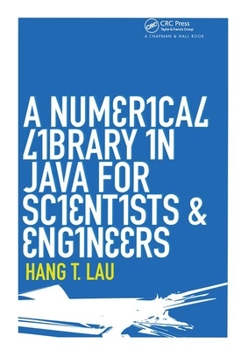A Numerical Library in Java for Scientists and Engineers
At last researchers have an inexpensive library of Java-based numeric procedures for use in scientific computation. The first and only book of its kind, A Numeric Library in Java for Scientists and Engineers is a translation into Java of the library NUMAL (NUMerical procedures in ALgol 60). This groundbreaking text presents procedural descriptions for linear algebra, ordinary and partial differential equations, optimization, parameter estimation,...
Format:Hardcover
Language:English
ISBN:1584884304
ISBN13:9781584884309
Release Date:August 2003
Publisher:CRC Press
Length:1088 Pages
Weight:0.75 lbs.
Dimensions:2.5" x 7.0" x 10.4"
Customer Reviews
3 ratings
all the nuts & bolts you need, wrapped in newspaper
Published by Thriftbooks.com User , 20 years ago
A true alternative to astronomically expensive numerical Java libraries. It contains a great collection of various algorithms, explains which one to choose, how to use it and what it does. In addition the Java source code is printed which is reason for the high page numbers and should answer even the most specific questions. Finally, there are many references to classic publications for further reading.This book provides all the information you'll need to solve most numerical problems (linear algebra, non-linear equations, ordinary differential equations, Fourier transform, special functions, time series,...) but unfortunately barely covers interpolation and approximation (e.g. no splines !). Oh, and the typesetting is a bit rough.Similar to open source projects, I expected the CD included with the book to contain source, a jar file and javadoc ready to be used. Instead you will find the Java sources (in a single "numal" package) and pre-compiled classes only. Algorithms are invoked via static methods in chapter-based classes such as "Basic", "FFT", "Linear_algebra" etc. I found the usage of "double[1]" rather than "double" a bit confusing. But fortunately the non primitive data types passed on to these methods are defined via interfaces, so no real restrictions when integrating to your project will apply.I suspect that the author has strong skills in older programming languages such as Fortran or C which may have influenced his Java style (no offense). So depending on how high your Java skills and expectations are, you might have to spend a few minutes re-organising and refactoring the sources, running javadoc on it and packing it into a jar.Summarizing I'd say that I would not like to miss this book as it has saved me many hours implementing the methods by myself. If it also covered splines and presented the code more nicely I would definitely give it the missing extra star. The crucial information is there and at the end, that's what you need, right ?
A book of good value
Published by Thriftbooks.com User , 21 years ago
It is indispensable to have the source code of such a high quality numerical library to experiment on the PC.
Very useful numerical Java library with source code
Published by Thriftbooks.com User , 21 years ago
This book contains some much needed source code of a comprehensive numerical library in Java. This provides a basis for students and researchers to evaluate different numerical methods. For beginners, the library can be used as a black box for solving a wide range of numerical problems. More experienced users can build new modules based on the existing ones, or modify the source code for experimentation.






